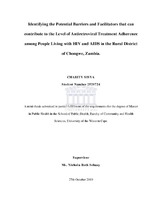| dc.description.abstract | According to the Demographic and Health Survey in Zambia the national HIV prevalence among population aged 15-49 years was 14%. In 2002 the Government of Zambia introduced Antiretroviral Therapy (ART) in two of the largest hospitals in Zambia: Lusaka and Ndola hospitals. As many people begin accessing ART in rural areas in Zambia, one of the major challenges is ensuring that those receiving ART adhere to treatment to avoid the emergence of drug resistance and treatment failure. The research therefore set to identify the potential barriers and facilitators to antiretroviral treatment adherence among people living with HIV and AIDS in the rural district of Chongwe,Zambia.A descriptive qualitative study was conducted over a period of three weeks from 11th December to 29th December 2008. The perceptions, opinions and experiences of PLHIV on ART and those of the health workers and treatment supporters were explored through in-depth interviews and focus group discussions. In-depth interviews were conducted with nine persons living with HIV (PLHIV): 5 females and 4 males. Two focus group discussions were conducted with members of 2 different PLHIV support groups from Refunsa and Chimusanya villages served by the ART clinic of St Luke Mission Hospital and another with a group of ART treatment supporters. In addition, interviews were held
with five key informants, who were health workers from the ART clinic in St Luke
Mission Hospital in Mpanshaya.Reported barriers to adherence among PLHIV in rural areas included experiencing side effects to ART drugs, stopping medication due to improvement in wellbeing, a lack of understanding of the importance of adherence, and forgetting to take their medication due to alcohol consumption. Other barriers included stigma and discrimination, inadequate food to support ART uptake and non disclosure of one’s status for fear of being rejected especially for women who feared rejection in relationships. Another key barrier to adherence was the religious belief held by some PLHIV that one would get healed after being prayed for and therefore discontinued treatment.Key facilitators to adherence identified in the study included getting into a regular routine of taking antiretroviral drugs (ARVs), knowledge of and belief in the efficacy of ART, disclosure of HIV status, access to social support and nutritional support. Other facilitators identified were use of treatment supporters who provided support to PLHIV by providing them with on-going adherence counseling, and making referrals to the ART facility for further support, mobile ART clinics that have brought ART services closer to
the rural communities and the adaptation of strategies such as clocks and use of alarms by PLHIV to remind them to take their medication. Although better health resulting from taking ARVs was citied as a barrier to adherence it also acted as a facilitator to adherence as better health motivated PLHIV to continue taking their medication.In conclusion, based on the findings from the study a series of recommendations were made to inform the current ART adherence information and counseling strategies used by the ART facility at St Luke Mission Hospital in Mpanshaya - and other ART programmes being implemented in similar rural health facilities in Zambia. The recommendations included the need for the ART facility to address alcohol abuse among PLHIV taking ART, addressing perceptions on ARVs in the community, reviewing of the counseling programme, caring for treatment supporters, strengthening food security and livelihood opportunities for PLHIV and their families and increasing collaboration between the ART facility and the churches. | en_US |

